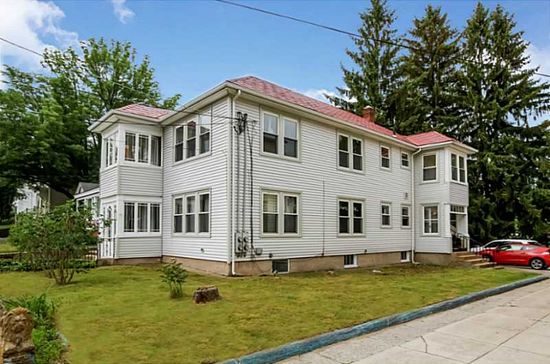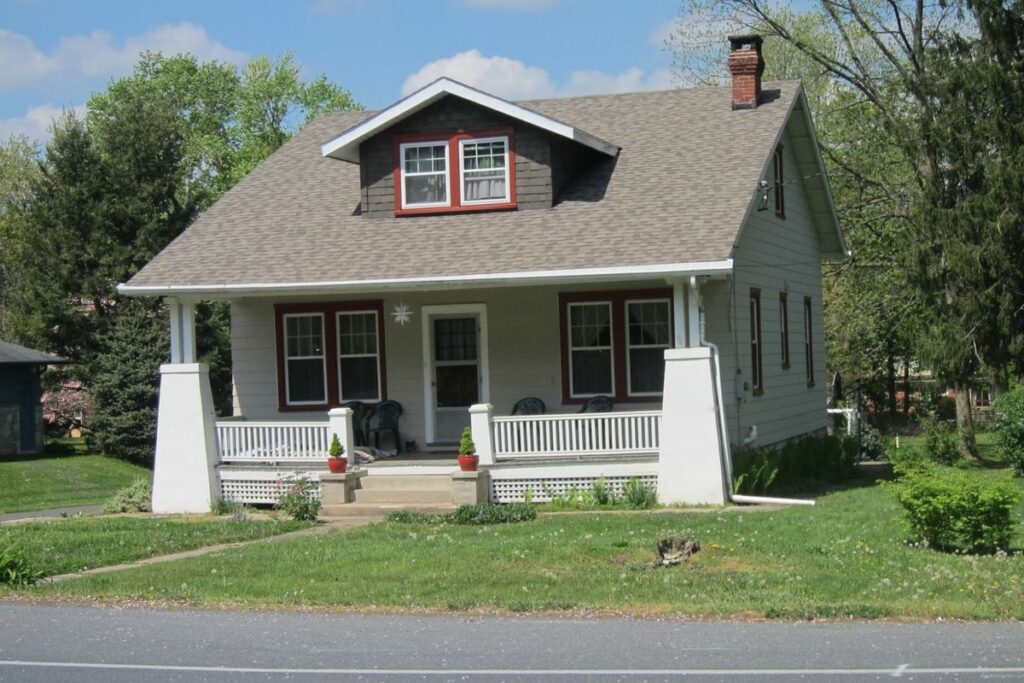It’s disappointing, but understandable, that more people don’t consider themselves “roof connoisseurs.” After all, most homeowners take their roofs for granted, as Bob Dylan put it, “shelter from the storm.” Oh, but accounting for only a mere 3% of the total house construction cost, a roof is so much more than that! 😉
Aside from the roof covering material selection, what really gives your roof personality is its design and construction, how roof peaks and valleys merge together.
Some people might not be aware they have multiple choices regarding the roof design on a new construction home, but here are the top 20 most popular roof styles for homes with their associated pros and cons.
Flat
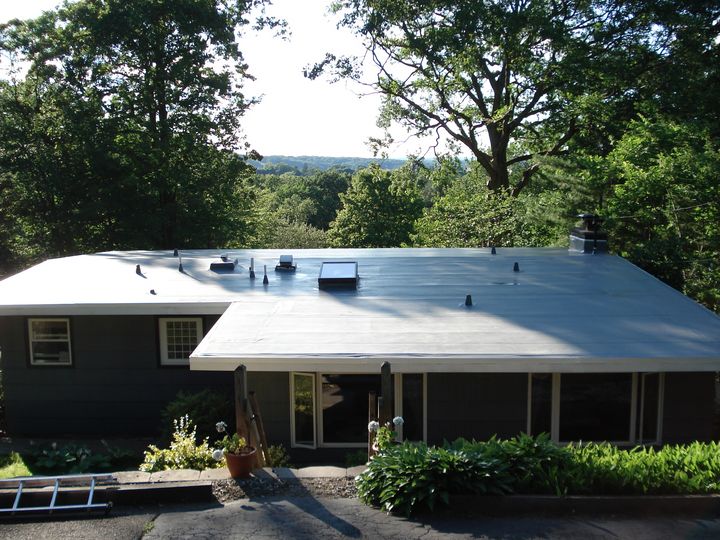
Most flat roofs are not really 100% flat, but rather they are low-sloped roofs that appear flat but have a little bit of slope to allow for the run-off of rainwater. Flat roofs are commonly found in modern architecture style homes, commercial buildings, or home additions like sunroom.
As the name implies, a truly flat roof would have no pitch, which could lead to the obvious problem of rainwater pooling up and creating a stagnant spa area for mosquitoes, bacteria, mold, etc.
The rainwater problem can be solved by centrally located drains, scuppers, and gutters to evacuate the water. Asphalt shingles and other traditional roofing materials are not viable options for low slope roofs.
Low-slope roofs are instead covered either by EPDM rubber, single-ply membranes, and multi-ply membranes, or a tar/asphalt coating that provides water protection.
PVC and TPO roofs are also viable options to explore. — They offer better longevity and durability compared to the EPDM rubber roofs.
Gable
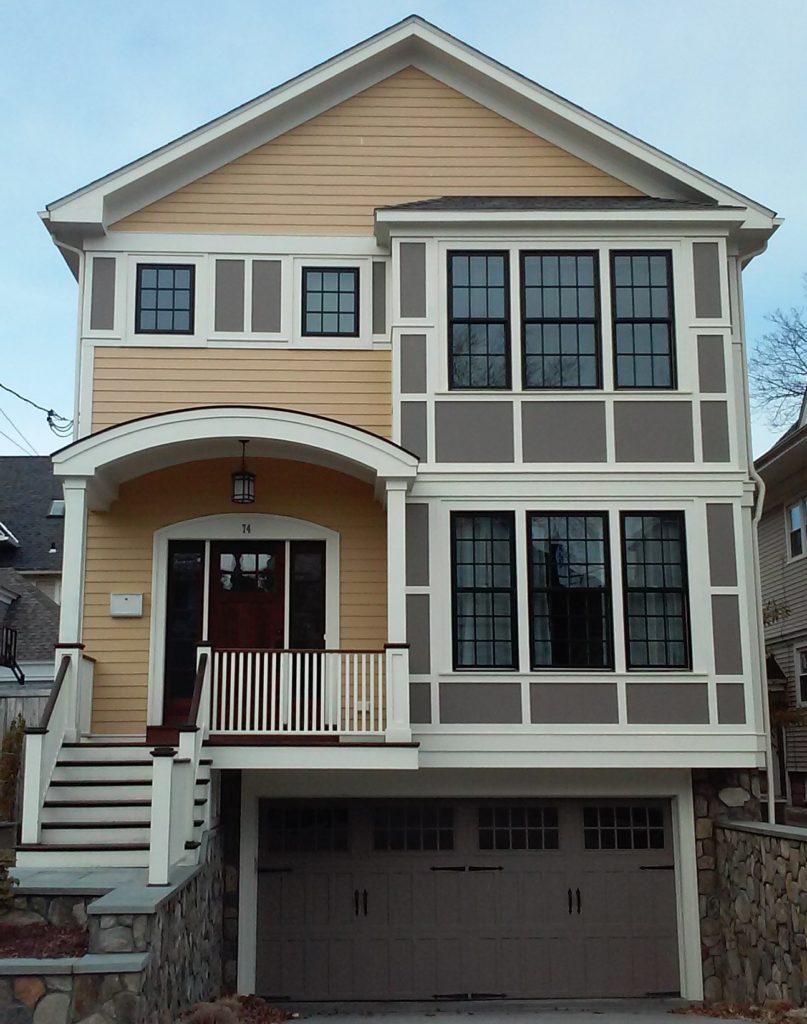
The term ‘gable’ refers to the triangular shape that is formed when the two pitched areas of the roof meet. It makes sense then that a gable style roof is basically one side up and the other side down similar to the roof on a traditional doghouse.
Did you know?
Roofing contractors love gable roofs, because gable shape entails covering only two flat surfaces without any hips or valleys to worry about, which means that virtually any type of roofing material can be used.
The gable design is available in almost any type of roof pitch, from low-slope ranch style homes to steep A-frames.
One of the only major problems with a gable roof is that they hang over creating eaves which are ripe for peeling off completely under the strong hurricane winds.
Roof frame strapping should be used for homes with gable roofs in high wind areas.
Hip or Hipped
One of the biggest problems with the gable roof style is that the two ends of the two houses will have no shade or cover because there are only two roofing surfaces. A hipped roof is the style of a roof shape that fixes such a problem. A hip roof is defined as ‘when all sides slope downwards towards the walls’.
Hipped roofs usually have four sides – two with triangular shapes and two with trapezoids. One of the difficulties with a hipped roof is matching materials between the sides and ends. They do perform better in high wind areas, however, especially with a pitch of 6/12 or 7/12.
Gablet (Dutch gable)
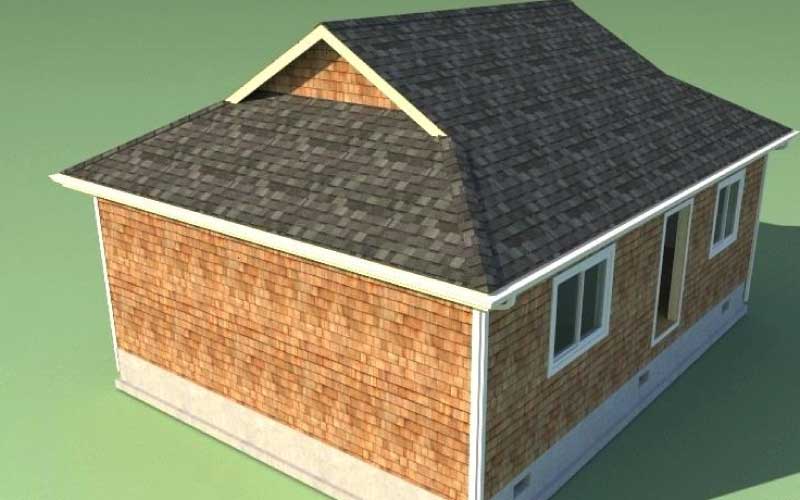
A casserole of roofs that solves the individual problems created in both the gabled and hipped design is the gablet (UK) or Dutch gable (North America) design.
A gablet basically puts a gabled roof on top of a hipped roof. The result is easier access to the lower portion (hipped) of the roof with the added benefits of natural light and attic or bedroom space (gable).
Most types of materials such as asphalt shingles and metal roofing can be used in a Dutch gable roof and in fact using variations in colors or types, actually adds a nice contrast.
Jerkinhead
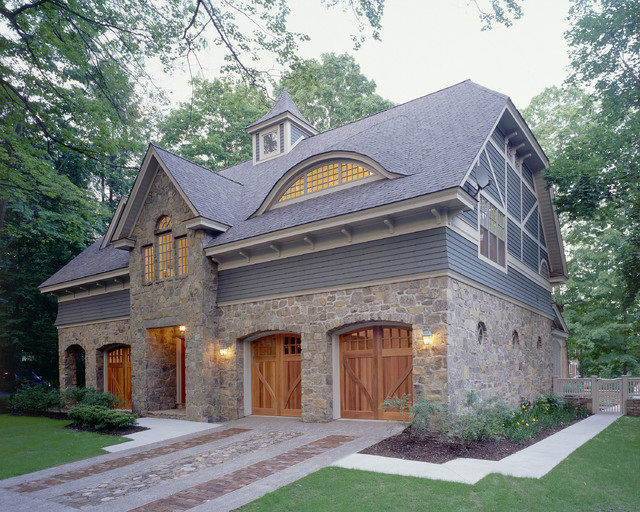
The jerkinhead design typically features mostly gable with a little bit of hipped influx mixed in. Gable roofs that are clipped into a short, hipped design on the ends are structurally superior to wind uplift.
Most sloped roofing materials except for heavy slates and tiles can be used on this type of roof shape.
This design is frequently seen on the second story of a house where the clipped hip doesn’t disrupt the view from a dormer window.
Saltbox
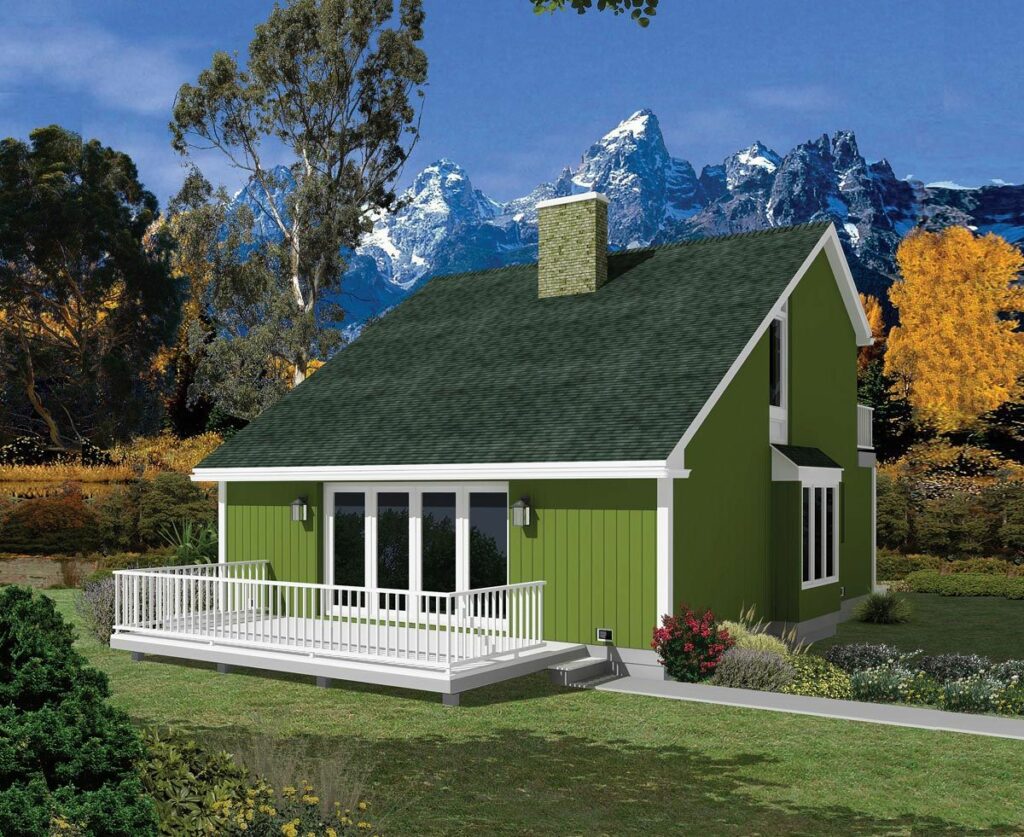
A saltbox-style roof is one that’s popular in New England and other Northeastern states. The asymmetrical design is trademarked by the front of the home having two stories compared to one story in the back.
The look resembles a profile view of the old salt boxes which utilized that design, so it was easier to pour.
The long protrusion of the rear roof portion extending almost to the ground makes it great for rainwater to disperse from.
One of the cons includes rooms on the backside of the house having slanted ceilings, limiting tall people to use essentially half the house. The saltbox does provide more wind resistance than a standard gable house though – perfect if you can get around the unique looks.
Catslide
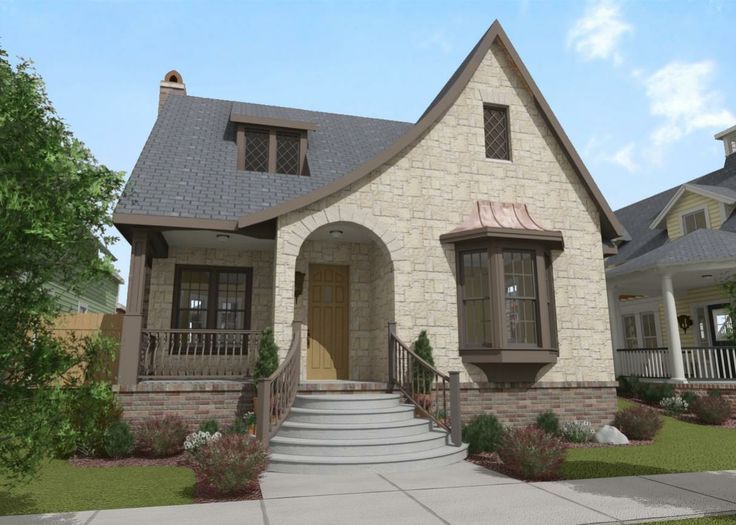
A catslide is very similar to a saltbox style roof except that they are often only used in portions of the back roof or on home additions.
Catslides extend beyond the eaves of a building, creating more depth at the cost of height. A catslide might be used as an extension into a mudroom/entrance or a transition into a three-seasons/sunroom.
Dormer
A dormer isn’t necessarily an independent roof type, but more of an addition to (or a feature) of an existent roofing style. A dormer is a window and a roof (gabled, hipped, flat, among others) that protrudes from the existing slope of a roof.
Like some contractors’ tool belts, a dormer can either be functional or just for show and aesthetics (false dormer).
A functional dormer creates usable space out of the roof of a building, adding natural light and headroom. A false dormer is blocked off from the interior and is only used to boost curb appeal from the exterior.
Dormers are usually, but not always, roofed in the same material as the house. To many roofing contractors, dormers are a nuisance and an extra spot where a leak could arise, but for homeowners they serve as a priceless reading nook or way to get some morning sunshine. 🙂
Shed Roof (Skillion)
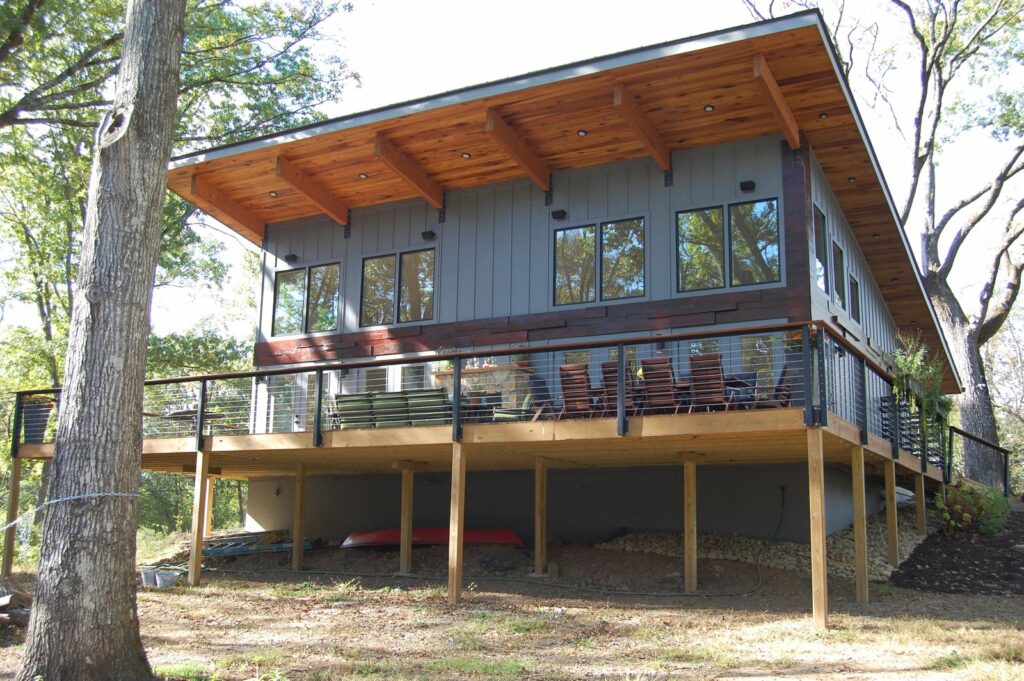
Most roofing styles are defined by how their various slopes tie-in to each other. The shed roof design however features no adjoining slopes as it is pitched in only one direction. This design is growing in popularity in modern homes while continuing to be a faithful option for, as the name implies, sheds.
Those who opt for shed roofs in their home do so to eliminate often impractical attic space with functional and aesthetic interior room. The design lends itself to a lot of natural light into the building while creating a unique profile in the neighborhood.
Shed roofs still have some pitch or slope, although one way, so they still allow rainwater to easily run off, making most roofing materials (assuming they meet the minimum slope requirements) including single-ply membrane roofs like PVC and TPO viable.
Lean-To
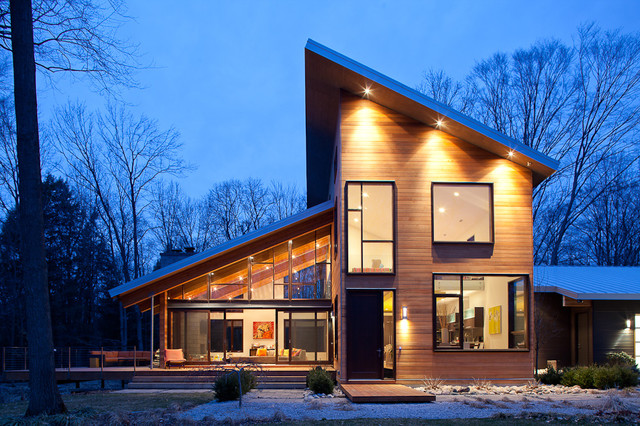
A lean-to is very similar to a shed roof except for the fact that its single slope feeds into the side of an existing building.
Some carport designs are technically lean-tos, but in modern construction they can also be found in additions such as a sunroom, home office, or a deck with a permanent awning.
While the lean-to building design may vary (open, enclosed), the roof planes can typically be covered by a standing seam metal roof, membrane roofing, or asphalt shingles.
Mansard
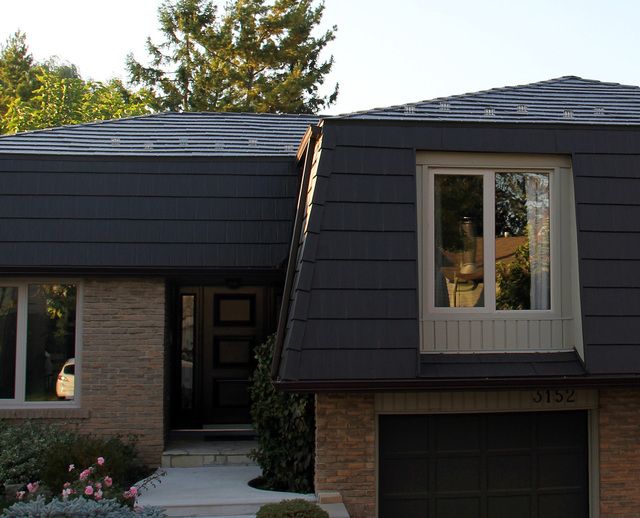
The French mansard design is perhaps the kind of roof that most looks like a comfortable hat to adorn your building. The profile of the roof actually features two slopes within one on each side. The bottom part of the roof slope is steeper so that the pitch of the roof barely starts. This allows more room on the inside and in most cases creates an extra story within the roof part of the building.
The top part of the roof slope is angled more as it meets up with an adjoining flat or low slope roof. Mansard roofs create extra space, but they can be a framing nightmare.
Metal roofing styles like metal shingles and standing seam are most popular because they avoid the difficult maintenance and access challenges down the line.
Gambrel
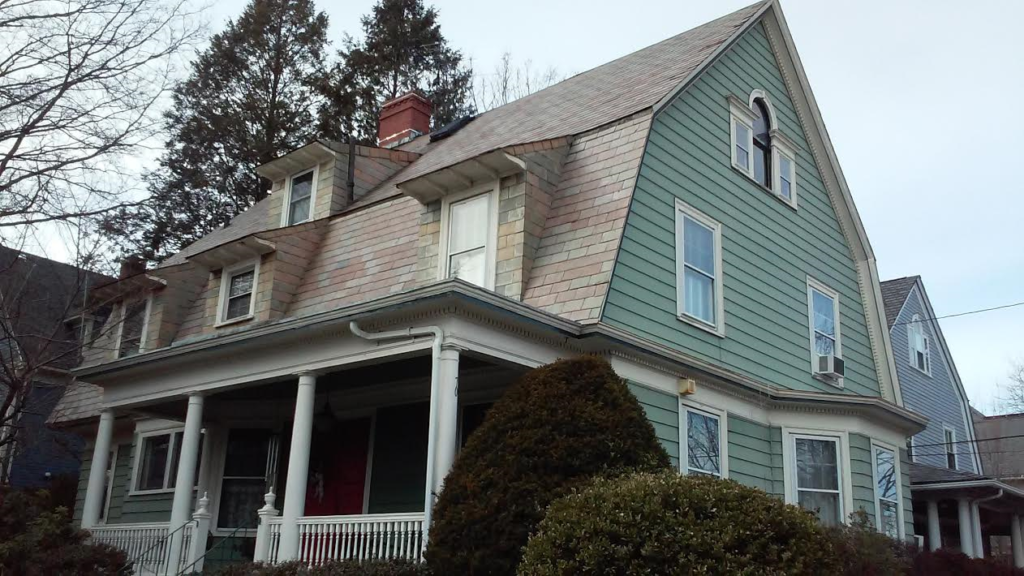
The Gambrel design is basically the same as the Mansard except the former has two slopes instead of four. You’ll be most familiar with this dual-sloped style as used in a barn and the design is often referred to as a barn roof.
The bottom of the slope is steep and nearly vertical before the top slope angles into the ridge. The design creates increased space as an attic can even be installed in the top sloped portion.
The open style and minimalist construction lend themselves to a couple of potential downfalls, however – the crumbling under heavy snow buildup and shaking in high winds. Metal is a long-term roofing material solution with its minimal maintenance, but you’ll notice many Gambrel roofs adorned with asphalt or even natural slate or wood shingles.
Rainbow Roof
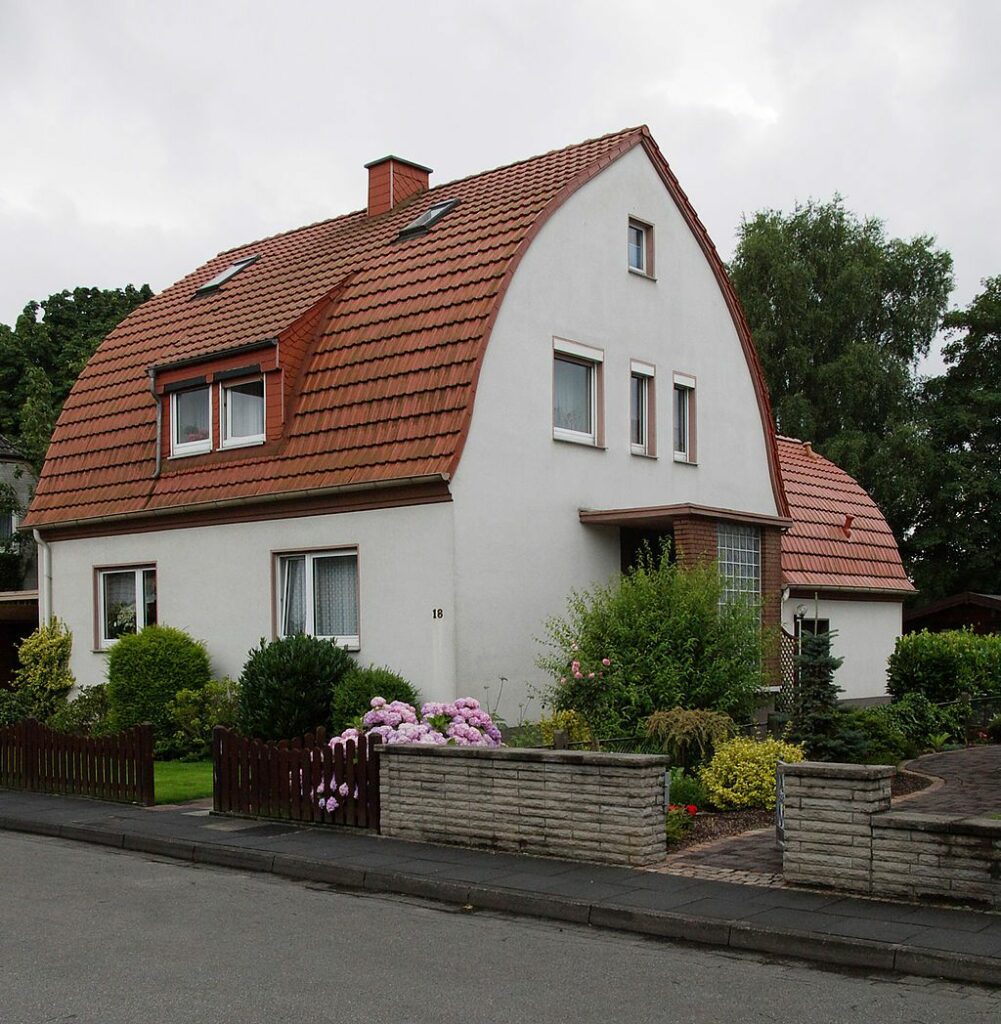
A rainbow roof is very similar to a Gambrel except for the fact it has an arch instead of two slopes. This design solves the problem of snow buildup especially when used on a single-story barn or garage. Something you’ll notice about many of the different roofing styles is that they contain characteristics of other types.
A rainbow roof for instance could technically be labeled a gable roof with two different “slopes” that meet at a ridge. The materials able to be used in a rainbow roof are also similar to those apt for a barn, or Gambrel, roof.
Bonnet Roof
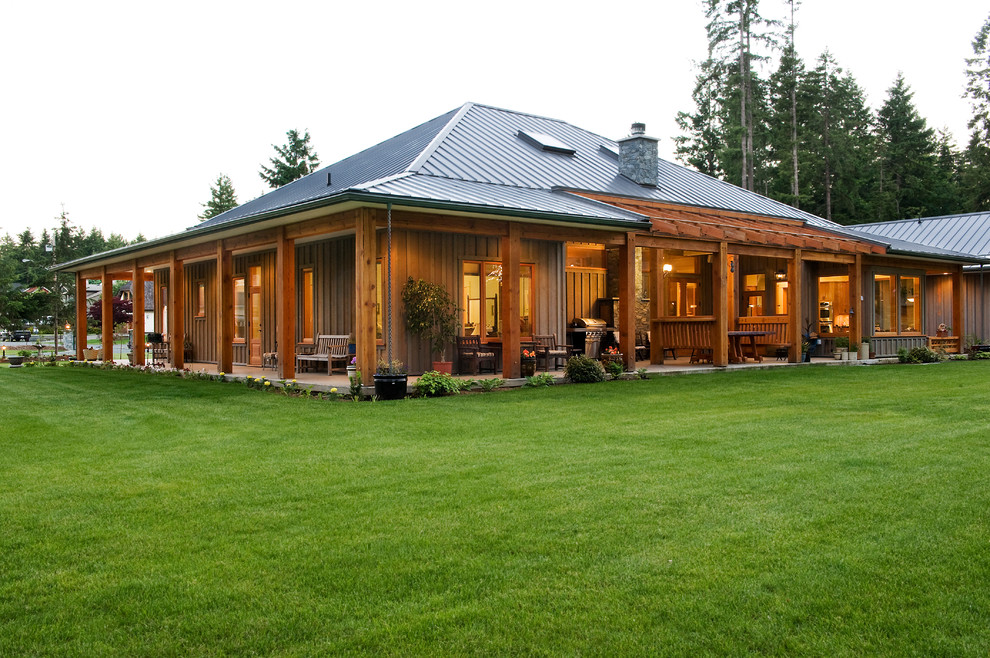
While the Mansard style is characterized by two slopes within a side – steep on the bottom to increase interior room and sloped at the top to connect to a ridge. The bonnet is basically that style, but in reverse. The top of the bonnet home slope is steep whereas the bottom is quite flat and extends well beyond the eaves of the home.
This design helps create a porch-like shaded area all around the building. The sloped top may seem like a waste of space but is actually great for creating vaulted ceilings or installing windows for natural light. The eaves extending beyond the house help to avoid water seeping around flashing and down the interior walls.
A bonnet roof lands itself nicely to a standing seam metal roof, thanks to its normally large span.
M-Shaped (multi-gable, ridged)
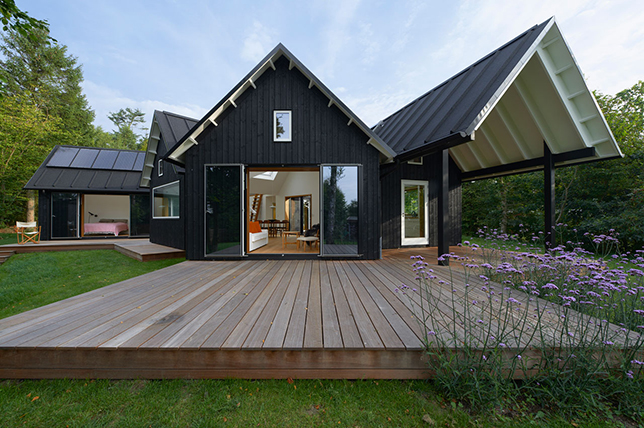
Much like how a rainbow roof has characteristics of multiple other styles, an M-shaped roof could basically be considered a ‘double gable’. The M-shaped roof features two sloped sides that meet in the middle with corresponding slopes on each side. This pattern could be repeated multiple times especially in condominiums or a strip mall.
The obvious downfall of this design would be snow and rain building up in the center where the two slopes meet but this is alleviated by a central gutter running from front to back, perpendicular to the front of the building. Even so, the pitch of M-framed roofs is generally steeper to assist in runoff and to ‘catch’ less rain and snow.
Butterfly Roof

One of the main reasons to clarify that M-shaped roofs not only meet in the middle but are also sloped on each side is because a butterfly roof style simply adjoins in the center and not the sides. This is a very modern design that is aesthetically unique like viewing a butterfly in flight while looking on from the exterior.
The design borrows some from the concept of the shed roof, avoiding a slope on the backside to allow more natural light and functional space into the interior.
A butterfly roof pitch is generally lower than an M-shaped roof because the butterfly must cover sometimes the entire area of a floor plan. Thus, more rainwater is captured which means increased drainage capacity is needed down the center.
Butterfly roofs should be covered with a durable low-slope roofing membrane like PVC, or with standing seam panels.
Hexagonal (tented)
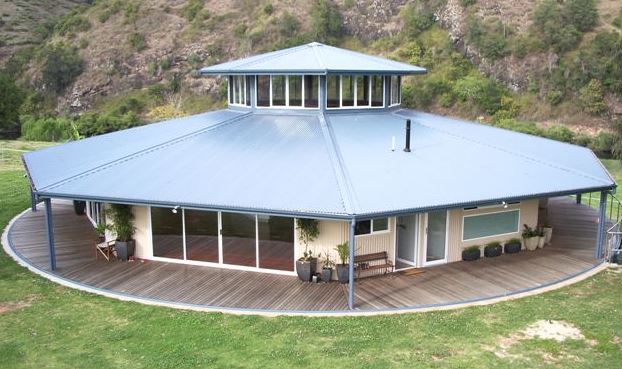
One of the biggest problems with creating a six- or eight-sided building such as a gazebo or shed is determining how to bring the roof together. Unless you go military style and adorn the building with a flat-top, the roof needs to have equal sides as the walls, which involves a lot of framing (high materials costs.)
Some hexagon-shaped roofs can tie into a smaller hexagonal shape at the top but either way there should be some slope. In recreational buildings virtually any type of material that is not too heavy can be used for the roof.
Clerestory
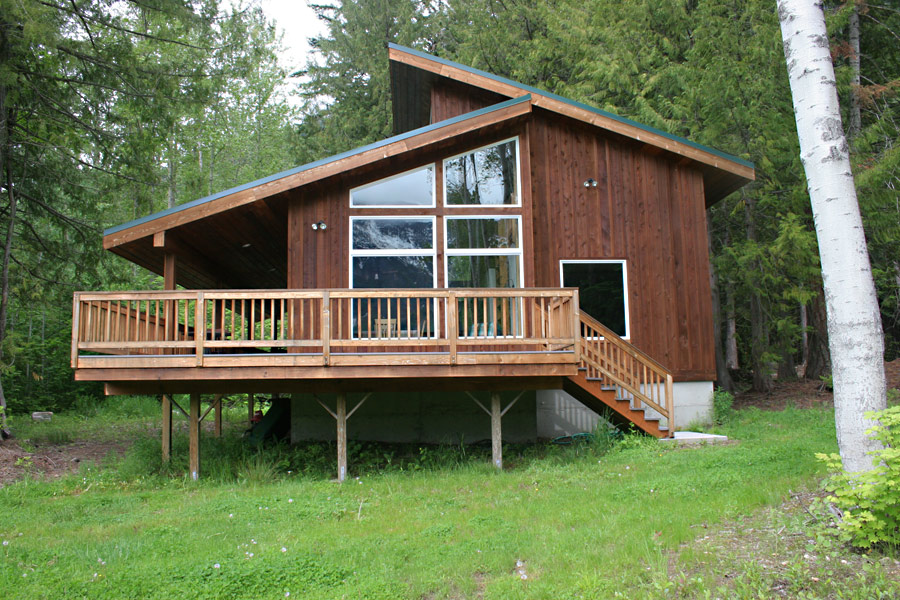
Clerestory roofs are built with one thing in mind – natural light. What they essentially amount to is a gable roof that meets at different heights. The bottom slope joints up a few feet lower which creates a location for a vertical wall. — This wall is outfitted with numerous windows that allow natural light and warmth into the adjacent room. Since the windows are up high, they provide privacy, but also are environmentally friendly with ‘free’ light and heat.
Virtually any material can be used on this roof type, but proper window installation is key since the clear path of the sun also presents an easy route for the rain.
Combination
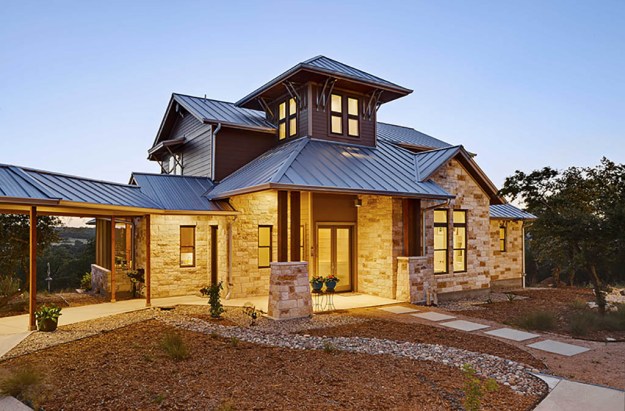
There is a broad scope when it comes to finding the perfect roof style for your needs. Not every type of roof shape or style is going to be ideal for your climate or even how your building is situated on the property (sunlight, wind, etc.) In these instances, custom, or combination, roofs are utilized to give you the best possible function for your building.
Combination roofs combine two or more different roof styles to create the one that is uniquely suitable for a particular house, climate, etc. The result also creates a unique curb appeal and a perfect opportunity to add contrast to your aesthetics.
The biggest risks of combination roofs are the roof junctions creating unnecessary end-walls and valleys where a potential flashing failure can lead to dreadful roof leaks, but also designing mismatched looks that are more of an eyesore than an asset.
Saw-tooth
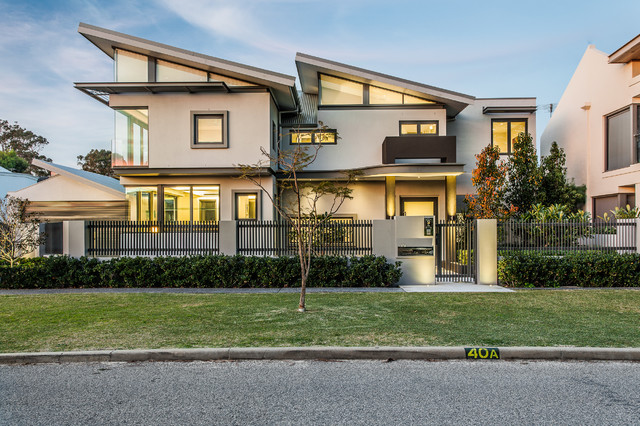
Sawtooth roofs were generally only used in industrial buildings until the popularity of eco-friendly homes began to rise. The profile of the roof looks just like a sawblade with an alternating slope-wall-slope-wall-slope design. The wall part of the roof is outfitted with windows just like a clerestory roof, which provides natural heat and light.
The slope sheds water into a central drain and creates a vaulted ceiling look on the interior. Since the design is used in eco-homes, environmentally friendly roofing materials like PVC and standing seam metal panels are generally used for this type of roof styles.
Some of the potential issues with Sawtooth roofs, are pooling of the accumulated rainwater and clogged drains on the roof, leading to premature roof leaks.
Closing Thoughts
Granted your home’s roof does keep out the rain, snow, and wind, but it also serves important insulating and ventilation properties.
A roof’s structure including the attic space and its venting and insulation is what often determines how energy efficient a home or a building will be — by either absorbing or reflecting the outside heat.
The roof shape can also greatly influence a home’s curb appeal and aesthetics by serving as the focal point of the building’s exterior or creating vaulted ceilings on the interior of the house.
What roof style do you find most appealing?
